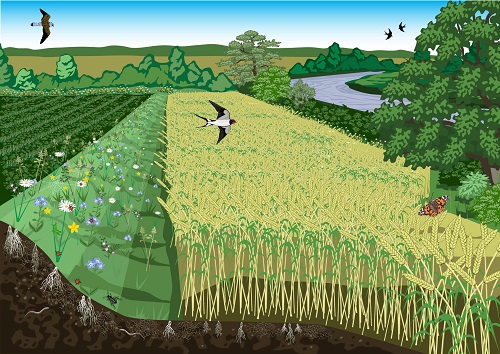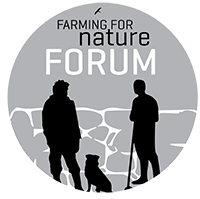Arable land
How farmers manage their arable fields and margins is important for farm wildlife. By managing 5-10% of your farm for biodiversity, you can make a huge difference for nature with relatively small effort.
Nature-friendly management practices can offer a host of benefits. For example:
- Improved soil structure, which reduces waterlogging and the impacts of droughts
- A healthy predatory insect population, which reduces the need for pesticides
- Reduced pesticide use, which benefits pollinators and can increase crop pollination
- Healthy soils, which capture more carbon
Actions on the Farm
REDUCED OR NO-TILLAGE
- A consequence of reduced, min- or no-till farming is that disturbance to the soil structure is reduced. Organic matter is then concentrated at the surface and breaks down more slowly. This allows beneficial organisms such as fungi and bacteria to break down the organic matter in the upper layers of the soil. A healthy earthworm population will also drag this organic matter below the surface, where it will release nutrients slowly over time. Combined with diverse crop-rotations and the use of cover crops, this approach can minimise weeds and diseases without relying on chemical methods.
COVER CROPS
- Planting winter cover crops prevents soil erosion and nutrient run-off into local waterways. Growing winter bird cover, for example, protects the soil, provides cover for animals moving through the field, controls weed levels and provides food for wildlife, especially seed-eating birds.
- These crops can also be used as green manures, which slowly release nutrients back into the soil, enriching it for the following crop.
- Including legumes in your cover crops will naturally fix nitrogen – this can benefit your soil, crop yields and local wildlife.
CROP ROTATION
- Changing the crop grown in a field every year prevents a build-up of the pests or diseases that are specific to any one crop.
BEETLE BANKS
- In autumn, create a ridge of earth about 40cm (16inches) high and 2m (about 6.5 feet) wide. Sow with tussock and mat-forming native grasses.
- To allow wildlife to move to and from the bank, the distance between it and the field boundary should be less than 25m.
- Cut as needed in the first summer; cutting when the grasses reach 10cm will encourage tussocks to form. After the first year, to ensure there are always undisturbed sections for wildlife, only cut on a 3-year rotation (i.e. cut one section one year, another section the next and so on).
- These banks provide a habitat for many beneficial predatory insects (e.g. spiders and ladybirds), which will move out onto your crop in spring, as well as providing feeding and breeding grounds for birds.
- More details on managing beetle banks can be found below.
GRASS & WILDFLOWER AREAS
- A native grass and/or wildflower strip or area in a field increases the value of the area for wildlife, especially pollinators.
- When positioned across a slope or adjacent to a waterway, these areas can also slow down run-off, helping to prevent it reaching nearby streams.
- Manage these areas in the same way as the beetle banks, i.e. regularly cut in the first year and then in sections every three years.
- Avoid pesticide use in the vicinity of grass and wildflower habitat areas.
- To allow wildlife to move more easily around the farm (i.e. improve habitat connectivity), connect these areas to field boundary habitats, ditches, watercourses and woodlands.
INTEGRATED PEST MANAGEMENT (IPM)
- IPM uses a variety of non-chemical methods to manage the pest burden on crops while also reducing the use of harmful inputs. This is especially important as over-use of chemicals can lead to resistance in the targeted pest species. Methods include:
- Promoting beneficial wildlife (by protecting hedgerows, grassy areas, herbal leys etc.)
- Crop rotation (to interrupt the life cycle of certain pests)
- Buffer-strips along field edges (to protect adjacent habitats from run-off or spray-drift)
- Sterile seedbeds (for weed-control)
- Targeted spot-treatment or targeted pesticide-use if absolutely necessary (avoid spray drift or watercourse contamination)
- Cleaning machinery (to prevent the spread of harmful organisms between sites)
- Weed management plans (considering the history of weed outbreaks on your farm and trying to identify the causes to prevent further outbreaks)
REDUCE CHEMICAL INPUTS
- Herbicides, pesticides, fungicides, molluscicides and fertilisers all harm biodiversity and damage soil health over time. Reduce their use where possible!
- Consider making your own compost, it acts as a fantastic slow-release fertiliser, builds soil health over time and is much more friendly to wildlife than synthetic fertilisers or slurry.
- The mushroom is the fruiting body of the fungus. Underground, each fungus has a complex network called a mycelium. Mycelia are made up of tiny hair-like structures called hyphae. These hyphae can stretch through the soil for many metres (or even kilometres!), breaking down organic matter and returning nutrients to the soil. Tillage, fungicides and chemical fertilisers break up these fungal hyphae and inhibit the growth of healthy, soil-enhancing mycelium. Eliminate fungicides to safeguard your soil’s mycelia!
ARABLE REVERSION
On some farms there may be less productive fields where you might consider allowing natural recolonisation e.g. with native grassland, scrubland or woodland.
- A low-maintenance step could simply involve leaving a segment of your field alone and letting nature reclaim it. You can start small and see what develops over time before extending the project.
- To promote connectivity, and allow wildlife to move more easily around your farm, link these new habitats with existing natural areas.
- You will need to watch out for invasive species and may need to act to limit their spread. Likewise, some management may be necessary to prevent a bracken/bramble/gorse monoculture from developing.
- For more information, check out the resources on rewilding in our external resources section.
See here for our information on indicator species which tell you what your soil is trying to.
For more information on how to farm for nature, search by
SECTOR HABITAT SEASON FAQS
FURTHER RESOURCES EMAIL US ANY SUGGESTIONS


